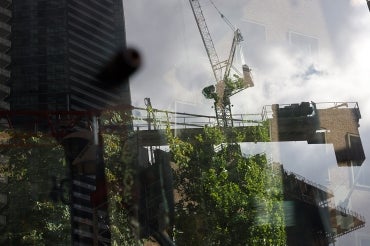Build more, pollute less: U of T research centre tackles need for sustainable infrastructure

Published: January 19, 2023
The newest research centre at the University of Toronto's Faculty of Applied Science & Engineering will develop innovative ways to meet the urgent and growing need for infrastructure – without further exacerbating the climate crisis.
The Centre for the Sustainable Built Environment brings together seven researchers from across U of T, as well as a dozen companies in construction and related industries. The goal is to identify strategies that will lower the environmental footprint by reimagining how new infrastructure is designed, where it is built and what materials are used in its construction.
“In Canada and around the world, we have a huge housing and infrastructure deficit – there’s a big social need to build much more than we have right now,” says Shoshanna Saxe, associate professor in the department of civil and mineral engineering and Canada Research Chair in Sustainable Infrastructure.
“At the same time, construction resource use accounts for up to a third of total global greenhouse gas emissions each year, a problem that is getting worse. It’s been estimated that if we continue current ways of construction, by 2050 the emissions due to new housing alone will cause us to blow past two degrees of global warming,” she adds. “If we want to avoid that, let alone reach net zero by 2050, we need to find ways to do more with less.”
Saxe and her collaborators – Evan Bentz, Chris Essert, Elias Khalil, Heather MacLean, Daman Panesar and Daniel Posen, all fellow U of T researchers – plan to approach this complex challenge from several different angles. Some efficiencies can be found by looking at where new housing is built, as well as what it looks like.
“The average person living in a city consumes fewer resources than the average person living in a suburb, because in a city you have more people per kilometre of sewer, road or electrical infrastructure. There are big rewards for well-designed cities,” Saxe says.
“The shape and types of buildings we build is also important. For example, Toronto has a lot of long skinny apartments, where a lot of the space is in the hallway. If we design differently, we can better use that space to provide more housing, or avoid [extra space] all together and save materials, emissions and cost.”
Saxe and her team have also shown that large concrete basements account for a high proportion of the emissions due to construction – building more of the structure above ground could improve the environmental bottom line. Other potential solutions involve alternative building materials, such as new types of concrete that are less carbon-intensive.
The multidisciplinary team – whose researchers cover a wide range of expertise, from carrying out life-cycle analysis of construction projects to defining national carbon budgets – will address issues well beyond the traditional bounds of engineering. For example, the group plans to explore the legal frameworks that translate established housing rights into practical built spaces.
“It’s absurd to say that the right to housing means that everyone has to live in a space the size of a closet,” Saxe says. “But it’s also absurd to expect everyone to have their own 3,500-square-foot house. Can we find a middle ground where everyone can live in dignity, without consuming in a way that threatens the planet?”
The research collaboration includes 12 external partners in the construction sector: Colliers; the Cement Association of Canada; Chandos Construction; Mattamy Homes; Northcrest; Pomerleau; Purpose Building, Inc.; ZGF Architects; Arup; SvN Architects + Planners; Entuitive; and KPMB Architects.
By working closely with this core group, Saxe and her collaborators aim to speed up knowledge translation, ensuring that the insights gained through their research can be applied in industry.
“The conversations we have with our partners can inform their design and construction, as well as the conversations they then have with their clients, raising everyone’s level of knowledge and awareness,” she says.
“We hope that by giving people – policymakers, designers and builders – the tools they need to address these challenges of building more with fewer emissions, we can improve outcomes across the built environment and create a more sustainable future for everyone.”



